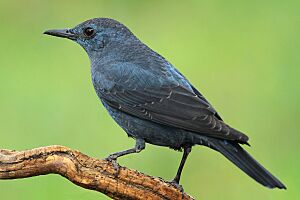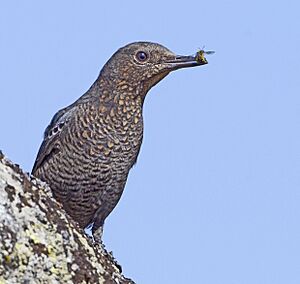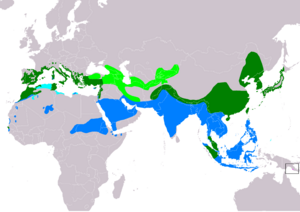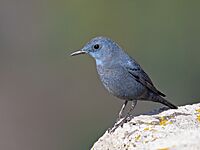Blue rock thrush facts for kids
Quick facts for kids Blue rock thrush |
|
|---|---|
 |
|
| Male M. s. solitarius | |
 |
|
| Female M. s. solitarius | |
| Conservation status | |
| Scientific classification | |
| Genus: |
Monticola
|
| Species: |
solitarius
|
 |
|
| Range of M. solitarius Breeding Resident Passage Non-breeding Vagrant (seasonality uncertain) | |
| Synonyms | |
|
Turdus solitarius Linnaeus, 1758 |
|
The blue rock thrush (Monticola solitarius) is a beautiful bird known for its striking blue-grey feathers. It's a type of chat, which is a small songbird. These birds were once thought to be part of the thrush family.
You can find blue rock thrushes living in southern Europe, northwest Africa, and across Asia, all the way to northern China and Malaysia. This special bird is the official national bird of Malta. In Maltese, it's called Merill. It was even featured on the old Maltese Lm 1 coins!
Contents
About the Blue Rock Thrush Name
Have you ever wondered how animals get their scientific names? For the blue rock thrush, a famous scientist named Carl Linnaeus first described it in 1758. He gave it the scientific name Turdus solitarius.
The name Monticola solitarius comes from Latin. Monticola means "mountain dweller," because these birds often live in rocky, mountainous areas. The word solitarius means "solitary," which describes how these birds often live alone.
Scientists used to group the blue rock thrush with the thrush family. But now, after studying their DNA, they know these birds are more closely related to Old World flycatchers. This means they are part of the Muscicapidae family.
Different Types of Blue Rock Thrushes
There are five main types, or subspecies, of the blue rock thrush. They look a bit different and live in various parts of the world:
- M. s. solitarius: Found in northwest Africa, southern Europe, and parts of Turkey and Azerbaijan.
- M. s. longirostris: Lives from Greece and Turkey through the Middle East to India and northeast Africa.
- M. s. pandoo: Found from the central Himalayas to eastern China and Vietnam.
- M. s. philippensis: Spreads from eastern Mongolia to Japan, the Philippines, and Indonesia.
- M. s. madoci: Lives in the Malay Peninsula and northern Sumatra.
Scientists are even thinking about splitting the blue rock thrush into two separate species. One would be a western group, and the other an eastern group.
What Does the Blue Rock Thrush Look Like?
The blue rock thrush is about the size of a starling, measuring around 21 to 23 centimeters (about 8 to 9 inches) long. It has a long, thin beak.
If you see a male blue rock thrush during breeding season, you'll easily spot it! It's almost entirely blue-grey, except for its darker wings. Females and younger birds are not as colorful. They have dark brown backs and lighter brown, scaly-looking undersides.
The male of the M. s. philippensis subspecies has a reddish-chestnut color on its chest and belly. Unlike some other thrushes, neither the male nor the female blue rock thrush has reddish outer tail feathers.
Its Song
The male blue rock thrush sings a clear and beautiful song. It's a melodious call, similar to a rock thrush's song, but much louder.
Where Do Blue Rock Thrushes Live?
Blue rock thrushes live in many parts of the world. Birds in Europe, north Africa, and southeast Asia usually stay in the same area all year. They might move to different altitudes depending on the season.
Other populations in Asia are more migratory. This means they travel long distances. They spend their winters in places like sub-Saharan Africa, India, and southeast Asia.
This bird is quite rare in northern and western Europe. It has only been seen twice in North America. Once was in British Columbia in 1997, and again in Oregon in 2024.
How Do Blue Rock Thrushes Behave?
Blue rock thrushes like to breed in open, mountainous areas. They build their nests in cracks in rocks or walls. A female usually lays 3 to 5 eggs.
These birds are omnivores, meaning they eat both plants and animals. Their diet includes a variety of insects and small reptiles. They also enjoy eating berries and seeds.
Gallery
-
Male in January, Gamla Nature Reserve, Israel




